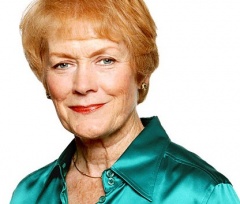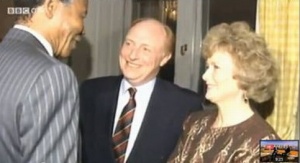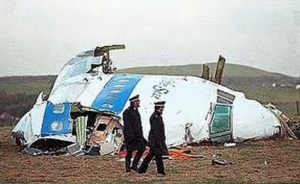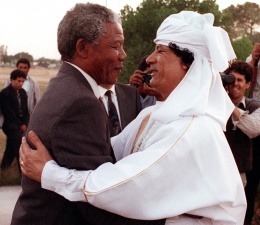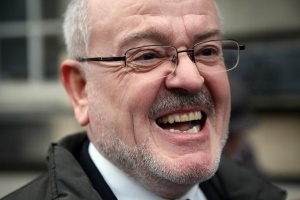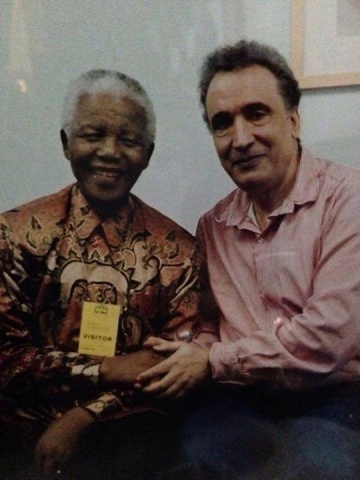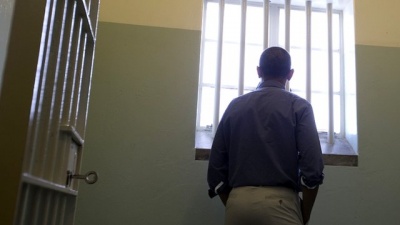Difference between revisions of "Nelson Mandela"
(→Blackout of Mandela blueprint: Adding image) |
(→Enter Tiny Rowland: Wikifying) |
||
| (One intermediate revision by the same user not shown) | |||
| Line 131: | Line 131: | ||
===Enter Prof Black=== | ===Enter Prof Black=== | ||
| − | [[File:Professor_Black.JPG|200px|thumb|right| | + | [[File:Professor_Black.JPG|200px|thumb|right|[[Robert Black|Prof Robert Black QC]] ]] |
[[Robert Black]], Emeritus Professor of Scots Law at Edinburgh University, intervened in the negotiations to bring the two accused to trial following the blueprint set out by Nelson Mandela. Black explained:<ref>[http://lockerbiecase.blogspot.co.uk/2009/10/al-megrahi-defence-knew-bomb-fragment.html "Al-Megrahi defence knew bomb fragment was sent to US"]</ref><blockquote>"I first became involved in the Lockerbie affair in January 1993. I was approached by representatives of a group of British businessmen whose desire to participate in major engineering works in Libya was being impeded by the UN sanctions. They had approached the then Dean of the Faculty of Advocates (the head of the Scottish Bar) and asked him if any of its members might be willing to provide advice to them - on an unpaid basis! - on Scottish criminal law and procedure in their attempts to unblock the logjam. The Dean of Faculty, Alan Johnston QC (later Court of Session judge Lord Johnston), recommended me. The businessmen asked if I would be prepared to provide independent advice to the government of Libya - again on an unpaid basis - on matters of Scottish criminal law, procedure and evidence with a view (it was hoped) to persuading them that their two citizens would obtain a fair trial if they were to surrender themselves to the Scottish authorities. There was, of course, never the slightest chance that surrender for trial in the United States could be contemplated by the Libyans, amongst other reasons because of the existence there of the death penalty for murder."</blockquote> | [[Robert Black]], Emeritus Professor of Scots Law at Edinburgh University, intervened in the negotiations to bring the two accused to trial following the blueprint set out by Nelson Mandela. Black explained:<ref>[http://lockerbiecase.blogspot.co.uk/2009/10/al-megrahi-defence-knew-bomb-fragment.html "Al-Megrahi defence knew bomb fragment was sent to US"]</ref><blockquote>"I first became involved in the Lockerbie affair in January 1993. I was approached by representatives of a group of British businessmen whose desire to participate in major engineering works in Libya was being impeded by the UN sanctions. They had approached the then Dean of the Faculty of Advocates (the head of the Scottish Bar) and asked him if any of its members might be willing to provide advice to them - on an unpaid basis! - on Scottish criminal law and procedure in their attempts to unblock the logjam. The Dean of Faculty, Alan Johnston QC (later Court of Session judge Lord Johnston), recommended me. The businessmen asked if I would be prepared to provide independent advice to the government of Libya - again on an unpaid basis - on matters of Scottish criminal law, procedure and evidence with a view (it was hoped) to persuading them that their two citizens would obtain a fair trial if they were to surrender themselves to the Scottish authorities. There was, of course, never the slightest chance that surrender for trial in the United States could be contemplated by the Libyans, amongst other reasons because of the existence there of the death penalty for murder."</blockquote> | ||
Since Lord Johnston died on 14 June 2008, we only have Prof Black’s word that it was Lord Johnston who recommended him to the 'group of British businessmen' whom Black has resolutely refused to identify. | Since Lord Johnston died on 14 June 2008, we only have Prof Black’s word that it was Lord Johnston who recommended him to the 'group of British businessmen' whom Black has resolutely refused to identify. | ||
===Enter [[Tiny Rowland]]=== | ===Enter [[Tiny Rowland]]=== | ||
| − | In fact, the mystery group was none other than Lonrho PLC, whose chief executive [[Tiny Rowland]] (allegedly an MI6 agent) head-hunted that other asset of British intelligence, Professor [[Robert Black]].<ref>[http://www.nickdavies.net/1990/08/01/tiny-rowland-portrait-of-the-bastard-as-a-rebel/ "Tiny Rowland: Portrait of the Bastard as a Rebel"]</ref> Lonrho's Sir John Leahy – former ambassador to South Africa – supported Prof Black in his primary task which was to cover-up the targeting by apartheid South | + | In fact, the mystery group was none other than Lonrho PLC, whose chief executive [[Tiny Rowland]] (allegedly an MI6 agent) head-hunted that other asset of British intelligence, Professor [[Robert Black]].<ref>[http://www.nickdavies.net/1990/08/01/tiny-rowland-portrait-of-the-bastard-as-a-rebel/ "Tiny Rowland: Portrait of the Bastard as a Rebel"]</ref> Lonrho's Sir John Leahy – former ambassador to South Africa – supported Prof Black in his primary task which was to cover-up the targeting by apartheid [[South Africa]]’s regime of Lockerbie’s highest profile victim: [[UN Commissioner for Namibia]], [[Bernt Carlsson]].<ref>[http://www.facebook.com/photo.php?fbid=4515519560289&l=09d2973e30 "Bernt Carlsson: Assassinated on Pan Am Flight 103"]</ref> [[Tiny Rowland]] went on to finance the 1994 documentary ''[[The Maltese Double Cross]]'' in which he made the amazing claim that a 23-strong [[South Africa]]n delegation - including foreign minister [[Pik Botha]] - were booked on [[Pan Am Flight 103]] of 21 December 1988 but had been given a "warning from a source which could not be ignored" and changed flights. [[Tiny Rowland|Rowland]]'s claim was later proved to be false: [[Pik Botha]] and his delegation had always been booked on the earlier Pan Am Flight 101 to New York for their attendance at the signing ceremony of [[Namibia]]'s independence agreement at United Nations headquarters in New York on 22 December 1988.<ref>[http://www.facebook.com/photo.php?fbid=1952368883124&l=30069eb4a1 "Why the Lockerbie flight booking subterfuge, Mr Botha?"]</ref> |
===Back to [[Robert Black|Black]]=== | ===Back to [[Robert Black|Black]]=== | ||
Revision as of 17:01, 23 October 2014
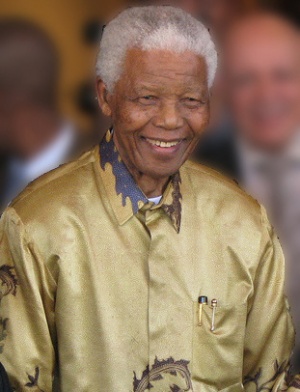 Mandela in Johannesburg, on 13 May 2008 | |
| Born | Rolihlahla Mandela 18 July 1918 Mvezo, Cape Province, South Africa |
| Died | 5 December 2013 (aged 95) Johannesburg, Gauteng, South Africa |
| Nationality | South African |
| Alma mater | University of Fort Hare University of London External System University of South Africa University of the Witwatersrand |
| Children |
step children
|
| Spouse | Evelyn Ntoko Mase (m. 1944–1957; divorced) Winnie Madikizela (m. 1958–1996; divorced) Graça Machel (m. 1998–2013; his death) |
| Subpage | •Nelson Mandela/Lockerbie involvement |
Nelson Rolihlahla Mandela (18 July 1918 - 5 December 2013) was the first black President of South Africa (10 May 1994 – 14 June 1999), and was elected on a universal franchise mandate at the end of the apartheid era, promising he would serve for just one 5-year term.
Nelson Mandela's presidency is notable for the establishment of the South African Truth and Reconciliation Commission (which granted amnesty to those who admitted to politically motivated crimes committed during the apartheid years) and for President Mandela's efforts to resolve the long running dispute between the United States, Britain and France, and Libya in relation to the 1988 Lockerbie bombing.[1]
South Africa's first black president and anti-apartheid icon Nelson Mandela is dead, South Africa's President Jacob Zuma announced on 5 December 2013. Mr Mandela, 95, led South Africa's transition from white-minority rule in the 1990s, after 27 years in prison. He had been receiving intense home-based medical care for a lung infection after three months in hospital. In a statement on South African national TV, Mr Zuma said Mr Mandela had "departed" and was at peace. "Our nation has lost its greatest son," President Zuma said.[2]
On 27 February 2014, it was reported that Jacob Zuma was "very busy" and could not attend the Nelson Mandela Memorial Service at Westminster Abbey on Monday 3 March 2014 which 1,800 people were expected to attend including Prime Minister David Cameron and Prince Harry.[3]
Mac Maharaj, President Zuma’s official spokesman, said:
- "His diary is always subject to change. This is a very, very busy period."
In South Africa, the change of plan was interpreted as a calculated snub by President Zuma who made no secret of his fury over the 2011 British and American-led invasion of Libya that led to the killing of Colonel Gaddafi, refusing to see Michelle Obama, the US First Lady, when she visited his country some months later.[4] In June 2013, Nelson Mandela reportedly snubbed the visiting President Barack Obama for the same reason.[5]
Contents
- 1 Biggest funeral in history
- 2 Background
- 3 Umkhonto we Sizwe
- 4 Perfect alibi for Lockerbie
- 5 Finally released
- 6 Statement on Lockerbie
- 7 Mandela visits Megrahi
- 8 Mandela snubs Obama
- 9 SA mercenaries "betrayed Gaddafi"
- 10 Personal life
- 11 Health
- 12 Related Documents
- 13 References
- 14 See also
- 15 External links
Biggest funeral in history
Cuba's president, Raúl Castro, joined Barack Obama and South Africa's president, Jacob Zuma, among the speakers paying tribute to Nelson Mandela on Tuesday 10 December 2013 at what has been described as the biggest funeral in history.
The memorial service in Johannesburg, in effect the first leg of a funeral that culminated with Mandela's burial on Sunday 15 December 2013, included interfaith prayers, eulogies by four of Mandela's grandchildren and speeches by the presidents of Brazil, Namibia, India and Cuba, along with the vice-president of China. Jacob Zuma delivered the keynote address.
For dignitaries attending the service, not least Obama and Castro, a potential diplomatic minefield awaited. But Zelda la Grange, Mandela's personal assistant for more than a decade, told Reuters:
- "Tomorrow, people should all be honouring their relationship with Madiba. If it means shaking hands with the enemy, yes, I would like to see that. That is what Nelson Mandela was and actually is – bringing people together despite their differences."
The cover of the official memorial programme was entitled "State memorial service for the late former president Nelson Rolihlahla Mandela" above a picture of South Africa's first black president smiling and wearing a characteristically flamboyant shirt. Inside the programme was an obituary over two pages that concluded:
- "Mr Mandela is survived by his wife, Graca, three daughters, 18 grandchildren and 12 great-grandchildren."
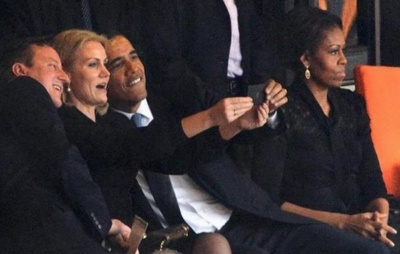
Barack Obama and his wife, Michelle, was joined by the former presidents Jimmy Carter, Bill Clinton and George W Bush. Also attending from Britain were Tony Blair, Gordon Brown, David Cameron and John Major, the UN Secretary-General Ban Ki-moon, and assorted princes and princesses, and celebrities including Bono, Oprah Winfrey and the Spice Girls. Mandela dubbed the last his "heroes" after meeting the pop group 16 years ago.[6]
During Nelson Mandela's memorial service in Soweto, Helle Thorning-Schmidt took a photograph on her mobile phone which immediately made worldwide news. According to the Daily Mirror:
- "A memorial would not normally be regarded as the right place to pose for a ‘selfie’.
- "But a grinning David Cameron and Barack Obama did just that during the memorial for Nelson Mandela.
- "The two leaders squeezed up as Danish Prime Minister Helle Thorning-Schmidt took the snap on her camera phone.
- "Within minutes the photograph of the three leaders posing for the ‘selfie’ went viral on the internet, staking its claim to become the most famous - if controversial - taken so far."[7]
In Zelda la Grange's memoir "Good Morning, Mr Mandela", his former PA said Nelson Mandela would have laughed at the controversy over the "selfie" snapped by David Cameron, Barack Obama and Danish Prime Minister Helle Thorning-Schmidt at his memorial service.
- "They were there, they were there for the right reasons, they paid their respects, whatever else they did, he was very tolerant of people in that way, he wouldn't have seen it as being disrespectful at all," she wrote.[8]
Westminster Abbey Memorial Service
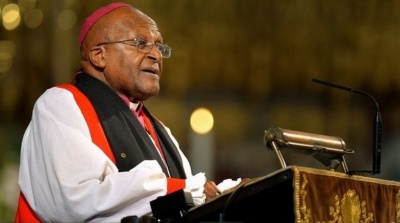
On 3 March 2014 at the Nelson Mandela Memorial Service in Westminster Abbey, Archbishop Desmond Tutu delivered the address, thanking international anti-apartheid campaigners "especially Bishop Trevor Huddlestone, the long-haired Peter Hain, Glenys and Neil Kinnock, and David Steel":
- "Without the anti-apartheid movement, without you extraordinary human beings, Nelson Mandela could so easily have died in prison."
Archbishop Tutu described journeying to Ronald Reagan's Oval Office and to Margaret Thatcher's Downing Street in the 1980s, pleading for economic sanctions to be imposed against the apartheid South African regime, and his pleas "falling on deaf ears". He was "surprised and delighted" when the US Congress passed the Comprehensive Anti-Apartheid Act in 1986, overriding President Reagan's veto.
Another speaker, former Government Minister and anti-apartheid campaigner, Peter Hain said that:
- Nelson Mandela "revered" Britain and never forgot it, even during his harshest years in jail on Robben Island.
- At the time, when the apartheid regime was at its most ruthless, there was a majority in the House of Commons against Mr Mandela and the African National Congress. But "tens of thousands" of British citizens supported Mr Mandela's fight for freedom.
Peter Hain also spoke of the "great privilege" of having known Nelson Mandela and his "impish and mischievous" sense of humour, citing the example of Mandela's "apologising for not attending our wedding in 2003 and saying perhaps I can come the next time".[9]
Background
Nelson Mandela was born in Transkei, South Africa on July 18, 1918. His father was Chief Henry Mandela of the Tembu Tribe. Mandela himself was educated at University College of Fort Hare and the University of Witwatersrand and qualified in law in 1942.
Nelson Mandela joined the African National Congress (ANC) in 1944 and was engaged in resistance against the ruling National Party's apartheid policies after 1948.[10][11]
Umkhonto we Sizwe
After the banning of the ANC in 1960, Nelson Mandela argued for the setting up of a military wing within the ANC. In June 1961, the ANC executive considered his proposal on the use of violent tactics and agreed that those members who wished to involve themselves in Mandela's campaign would not be stopped from doing so by the ANC. This led to the formation of Umkhonto we Sizwe.
Mandela was arrested in 1962 and sentenced to five years' imprisonment with hard labour. In 1963, when many fellow leaders of the ANC and the Umkhonto we Sizwe were arrested, Mandela was brought to stand trial with them for plotting to overthrow the government by violence.
His statement from the dock received considerable international publicity:[12]
"I have fought against white domination and I have fought against black domination. I have cherished the ideal of a democratic and free society in which all persons live together in harmony and with equal opportunities. It is an ideal which I hope to live for and to achieve. But if needs be, it is an ideal for which I am prepared to die."
On 12 June 1964, eight of the accused, including Mandela, were sentenced to life imprisonment. From 1964 to 1982, he was incarcerated at Robben Island Prison, off Cape Town; thereafter, he was at Pollsmoor Prison, nearby on the mainland. During his years in prison, Nelson Mandela's reputation grew steadily. He was widely accepted as the most significant black leader in South Africa and became a potent symbol of resistance as the anti-apartheid movement gathered strength. He consistently refused to compromise his political position to obtain his freedom.[13]
Perfect alibi for Lockerbie
In August 1988, Nelson Mandela was admitted to a luxury Cape Town clinic after contracting tuberculosis in Pollsmoor prison. On 7 December 1988, the Minister of Justice Kobie Coetsee announced that, following Mandela's complete recovery, he had been transferred to a "suitable, comfortable and properly secured home" adjacent to Victor Verster prison near the town of Paarl, some 30 miles from Cape Town.
Thus, when Pan Am Flight 103 was sabotaged over Lockerbie in Scotland on 21 December 1988, the African National Congress (ANC) leader remained in custody as a prisoner. Despite this perfect alibi, the apartheid regime were quick to accuse Nelson Mandela and the ANC of masterminding the Lockerbie bombing.
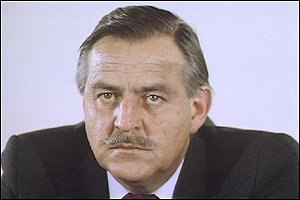
This amazing accusation was made on 11 January 1989 by South African Foreign Minister Pik Botha who had travelled to Stockholm in Sweden with other foreign dignitaries – including UN Secretary-General Javier Pérez de Cuéllar – to attend the memorial service of United Nations Commissioner for Namibia, Bernt Carlsson, the highest profile victim of the 270 fatalities at Lockerbie.[14]
Interviewed by Sue MacGregor on BBC Radio 4’s Today Programme, Pik Botha alleged that he and a 22-strong South African delegation, who were booked to fly from London to New York on 21 December 1988, had been targeted by the ANC. However, having been alerted to these ANC plans to kill him, Pik Botha said he managed to outsmart them by taking the earlier Pan Am Flight 101 from Heathrow to JFK, New York.[15]
Finally released
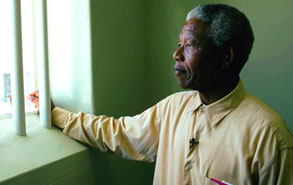
Having spent "ten thousand days" in prison in apartheid South Africa, Nelson Mandela was finally released on 11 February 1990. His first trip abroad at the end of February 1990 was to Lusaka in Zambia, where the ANC had been based for over ten years.[16] Then, on 21 March 1990, Mandela went to neighbouring Namibia (to join in celebrating Namibia’s independence from decades of illegal occupation by apartheid South Africa).
Soon afterwards, Mandela paid a visit to Libya to thank his friend Colonel Gaddafi for supporting the ANC throughout the apartheid years. Although the two Libyans, Fhimah and Megrahi, were not indicted until November 1991, the subject of the Lockerbie bombing would almost certainly have been discussed with Gaddafi by Mandela on this visit because of Pik Botha’s bizarre accusation against the ANC.[17]
Nelson Mandela chose Sweden as his first port of call in Europe because of all the support the ANC had received over many years from the Swedish government, especially from prime minister Olof Palme who was assassinated by agents of the apartheid regime in February 1986. Palme's deputy Ingvar Carlsson, who took over as prime minister in March 1986, invited British politicians Neil and Glenys Kinnock to come to Stockholm in April 1990 and greet Mr Mandela. That meeting was recalled by Neil Kinnock in a television interview on 8 December 2013 (three days after Nelson Mandela's death).[18]
After his release, Nelson Mandela plunged himself wholeheartedly into his life's work, striving to attain the goals he and others had set out almost four decades earlier. In 1991, at the first national conference of the ANC held inside South Africa after the organisation had been banned in 1960, Mandela was elected President of the ANC while his lifelong friend and colleague, Oliver Tambo, became the organisation's National Chairperson.
Statement on Lockerbie
On 21 January 1992, nearly two years after his release from prison, Nelson Mandela issued the following statement on the Lockerbie disaster:
"The ANC has consistently condemned all acts of terrorism. The Lockerbie disaster was a tragic incident which resulted in the unfortunate loss of innocent lives. The ANC once again takes the opportunity to express deepfelt sympathy to the families of the deceased. It is in the interest of peace, stability and security that if there is clear evidence of the involvement of identified suspects they should be arrested and punished as soon as possible. In the present climate of suspicion and fear it is important that the trial should not be intended to humiliate a head of state. It should not only be fair and just, but must be seen to be fair and just. This must be in the context of respect for the sovereignty of all countries.
"The ANC believes that if the above objectives are to be achieved, the following options should be considered:
- If no extradition treaty exists between the countries concerned, the trial must be conducted in the country where the accused were arrested;
- The trial should be conducted in a neutral country by independent judges;
- The trial should be conducted at The Hague by an international court of justice.
"We urge the countries concerned to show statesmanship and leadership. This will ensure that the decade of the Nineties will be free of confrontation and conflict."[19]
Mandela the mediator
Early in 1992, two years before the end of apartheid, Nelson Mandela made an informal approach to President George H W Bush with a proposal to have the two accused Libyans tried in a neutral country and by independent judges. Although President Bush reacted favourably to the proposal – as did President François Mitterrand of France and King Juan Carlos I of Spain – British Prime Minister John Major flatly rejected Mandela’s plan for the Lockerbie trial.
Enter Prof Black
Robert Black, Emeritus Professor of Scots Law at Edinburgh University, intervened in the negotiations to bring the two accused to trial following the blueprint set out by Nelson Mandela. Black explained:[20]
"I first became involved in the Lockerbie affair in January 1993. I was approached by representatives of a group of British businessmen whose desire to participate in major engineering works in Libya was being impeded by the UN sanctions. They had approached the then Dean of the Faculty of Advocates (the head of the Scottish Bar) and asked him if any of its members might be willing to provide advice to them - on an unpaid basis! - on Scottish criminal law and procedure in their attempts to unblock the logjam. The Dean of Faculty, Alan Johnston QC (later Court of Session judge Lord Johnston), recommended me. The businessmen asked if I would be prepared to provide independent advice to the government of Libya - again on an unpaid basis - on matters of Scottish criminal law, procedure and evidence with a view (it was hoped) to persuading them that their two citizens would obtain a fair trial if they were to surrender themselves to the Scottish authorities. There was, of course, never the slightest chance that surrender for trial in the United States could be contemplated by the Libyans, amongst other reasons because of the existence there of the death penalty for murder."
Since Lord Johnston died on 14 June 2008, we only have Prof Black’s word that it was Lord Johnston who recommended him to the 'group of British businessmen' whom Black has resolutely refused to identify.
Enter Tiny Rowland
In fact, the mystery group was none other than Lonrho PLC, whose chief executive Tiny Rowland (allegedly an MI6 agent) head-hunted that other asset of British intelligence, Professor Robert Black.[21] Lonrho's Sir John Leahy – former ambassador to South Africa – supported Prof Black in his primary task which was to cover-up the targeting by apartheid South Africa’s regime of Lockerbie’s highest profile victim: UN Commissioner for Namibia, Bernt Carlsson.[22] Tiny Rowland went on to finance the 1994 documentary The Maltese Double Cross in which he made the amazing claim that a 23-strong South African delegation - including foreign minister Pik Botha - were booked on Pan Am Flight 103 of 21 December 1988 but had been given a "warning from a source which could not be ignored" and changed flights. Rowland's claim was later proved to be false: Pik Botha and his delegation had always been booked on the earlier Pan Am Flight 101 to New York for their attendance at the signing ceremony of Namibia's independence agreement at United Nations headquarters in New York on 22 December 1988.[23]
Back to Black
Professor Black’s other important task was to frustrate Nelson Mandela’s plans in relation to bringing to trial the two Libyans who had been indicted in November 1991 and were accused of carrying out the Lockerbie bombing. Thus, in October 1993, seven months before Nelson Mandela’s government took over from the apartheid South African regime, Prof Black attended a meeting in Tripoli of an international team of lawyers representing the two accused Libyans, Fhimah and Megrahi. This team consisted of lawyers from Scotland, England, Malta, Switzerland and the United States and was chaired by the principal Libyan lawyer for the accused, Dr Ibrahim Legwell. A press release issued at the conclusion of the meeting indicated that the accused were not prepared to surrender themselves for trial in either Scotland or the United States. It subsequently transpired that the primary reason for this was their belief that, because of unprecedented pre-trial publicity over the years, neither a Scottish nor an American jury could possibly bring to their consideration of the evidence the degree of impartiality and open-mindedness that accused persons are entitled to expect and that a fair trial demands. The attitude of the Libyan Government was that it was satisfied (in part due to the information and advice supplied to it by Prof Black regarding the Scottish law of criminal evidence and procedure) that its citizens would obtain a fair trial in Scotland, but that it had no constitutional authority to hand them over to the Scottish authorities. The question of voluntary surrender for trial was one for the accused and their legal advisers, and while the Libyan Government would place no obstacles in the path of, and indeed would welcome, such a course of action, there was nothing that it could lawfully do to achieve it.[24]
Back to Tripoli
On 10 January 1994, four months before Nelson Mandela was inaugurated as President of South Africa, Prof Black visited Tripoli for a second time and, in a letter to Dr Legwell, suggested a means of resolving the impasse created by the insistence of the Governments of the United Kingdom and United States that the accused be surrendered for trial in Scotland or America and the adamant refusal of the accused to submit themselves to trial by jury in either of these countries. The proposal embodied the following five elements:
- That a trial be held outwith Scotland (perhaps in the premises of the International Court of Justice at The Hague) in which the governing law and procedure would be the law and procedure followed in Scottish criminal courts in trials on indictment.
- That the prosecution in the trial be conducted by the Scottish public prosecutor, the Lord Advocate, or his authorised representative.
- That the defence of the accused be conducted by independent Scottish solicitors and counsel appointed by the accused.
- That the jury of fifteen persons which is a feature of Scottish criminal procedure on indictment be replaced by an international panel of five judges presided over and chaired by a judge of the Scottish High Court of Justiciary whose responsibility it would be to direct the panel on Scottish law and procedure.²
- That any appeals against conviction or sentence be heard and determined in Scotland by the High Court of Justiciary in its capacity as the Scottish Court of Criminal Appeal.
Although not expressly stated in the proposal, it was the clear implication of its provisions that, in the event of the accused being convicted by the Court, they would serve any sentence of imprisonment imposed upon them in a prison in Scotland. In a letter to Prof Black dated 12 January 1994, Dr Legwell stated that this scheme was wholly acceptable to his clients, and if it were implemented by the Government of the United Kingdom the suspects would voluntarily surrender themselves for trial before a tribunal so constituted. By a letter of the same date the Deputy Foreign Minister of Libya stated that his Government would place no obstacle in the path of its two citizens should they elect to submit to trial under this scheme.[25]
Mandela's formal offer
On 29 May 1994 – less than three weeks after becoming President – Nelson Mandela wrote to John Major urging a resolution of the Lockerbie case:
- Mandela plea to Major on Lockerbie trial
- The South African president, Nelson Mandela, has written to John Major to urge a resolution of the conflict with Libya over the Lockerbie bombing, arguing that the continuing dispute is damaging relations among all African nations.
- News that Mr Mandela and the Prime Minister have debated the issue is a vindication for those who have long argued that the Lockerbie stalemate has implications beyond bringing those responsible to justice.
- A letter from the South African president to Downing Street and Mr Major's response, copies of which have been obtained by The Scotsman, show clearly that Lockerbie and the sanctions imposed to try to persuade Libya to hand over the two official suspects has been a regular topic for discussion between the two men.
- Libya has been largely economically isolated since it refused to hand over the men Britain and the US accuse of blowing up Pan Am Flight 103 over Lockerbie with the loss of 270 lives in December 1988.
- Mr Mandela writes: "The reason I raise the matter again is because of the damaging effect prolongation of the impasse is having on relations in Africa both within the Organisation of African Unity context and bilateral relations. In my meetings with African leaders invariably the matter comes up and there is the sense that an urgent solution should be sought."
- Mr Mandela goes on to urge Mr Major to re-consider his opposition to a trial in a neutral country "in the interest not only of Libya but of the continent, the Muslim world and international conciliation."
- However, Mr Major remains firm in his view that to accede to a trial under Scottish jurisdiction at The Hague, for example, would achieve nothing in terms of removing the possibility of prejudicial media coverage and, more importantly, would only set a dangerous precedent.
- He writes: "You can well imagine the sensitivity of asking the British Parliament to approve a law which would be interpreted by many as acceptance that a trial in Scotland would not be fair and as a concession to alleged terrorists."
- Mr Major finishes by urging Mr Mandela to use his influence with the Libyan leader, Colonel Gaddafi, to persuade him that accepting a trial in Scotland or the US is the only solution to the problem.
- The Linlithgow MP, Tam Dalyell, who has long campaigned for a resolution of the conflict with Libya over Lockerbie, said: "The fact that President Mandela...should take the trouble to write one of his rare letters to the British Prime Minister about this is an indication of the importance he attaches to this issue, which is Africa-wide."[26]
In November 1994, President Mandela formally offered South Africa as a neutral venue for the Lockerbie trial but this was again rejected by Prime Minister, John Major, who said that the British government did not have confidence in foreign courts. Prof Black’s views on Mandela's proposal for South Africa to host the Lockerbie trial are not known but, presumably, he was strongly opposed since the apartheid regime’s role in the Pan Am bombing would undoubtedly have come to light as a result of a South African trial. A further three years elapsed until Mandela's offer was repeated to Major's successor, Tony Blair, when President Mandela visited London in July 1997 and again at the 1997 Commonwealth Heads of Government Meeting (CHOGM) in Edinburgh between 24 and 27 October 1997. At the latter meeting, Mandela warned that "no one nation should be complainant, prosecutor and judge" in the Lockerbie case. Immediately before attending CHOGM, Mandela paid his first visit as President to Colonel Gaddafi in Libya, and visited Gaddafi again on 29 October 1997 which prompted speculation that Mandela was trying to mediate an end to the UN sanctions imposed on Libya over Lockerbie.[27]
Diplomatic intervention
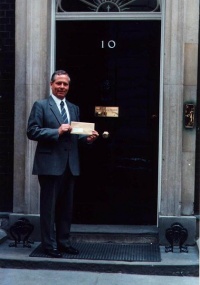
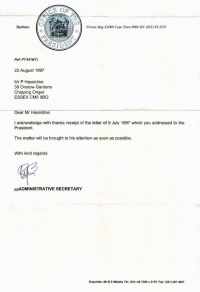
On 9 July 1997, former British diplomat Patrick Haseldine faxed a letter to His Excellency President Nelson Mandela (c/o the South African High Commission in London, Fax: 0171 451 7284):
- Dear Mr President,
- Lockerbie bombing and my dismissal from HM Diplomatic Service
- For writing to The Guardian newspaper on 7th December 1988 accusing the apartheid régime of state-sponsored terrorism, I was immediately suspended from the Diplomatic Service.
- Solicitor Geoffrey Bindman wrote supporting me to The Guardian a week later - Shabby manouevres that aid and abet Botha (copy follows) - but to no avail. I was sacked eight months later.
- With the recent change of government in Britain, I applied to the new Foreign secretary for reinstatement in the Diplomatic Service. Robin Cook replied on 16th May 1997 (copy follows) turning down my application because of elapsed time: "It is now a decade since your dismissal."
- If you have a moment during your forthcoming discussions with Prime Minister Blair, I should be very grateful if you would put in a word on my behalf. I am sure that Mr Blair will respond positively to such an approach, if not by reinstating me then by compensating me for loss of earnings and for full pension rights.
- You will no doubt also raise the Lockerbie question with Mr Blair (in which connection please see my letter of 15th January 1997 to High Commissioner Mr Msimang - copy follows). On the eve of your arrival in the UK, The Guardian reported that Germany has reopened its investigation into the Lockerbie bombing (copy follows). Since the "forensic" evidence against the two Libyans appears to be totally discredited by the information given to the Germans, I believe that the UK should now mount a judicial inquiry (perhaps under Sir Richard Scott) into Lockerbie. You may wish to persuade Mr Blair of the need for a rigorous inquiry into all aspects of the case.
- I remain convinced that state-sponsored South African terrorism was responsible both for the sabotage of Pan Am 103 and the crash which killed President Machel.
- Yours sincerely,
The President's Administrative Secretary replied by letter referenced P7-9316(T) and dated 22 August 1997:
- Dear Mr Haseldine
- I acknowledge with thanks receipt of the letter of 9 July 1997 which you addressed to the President.
- The matter will be brought to his attention as soon as possible.
- With kind regards
- Mr B S Mbatha
Influence in parliament
On 7 November 1997, Labour MP Tam Dalyell began a House of Commons debate by revealing the influence of both British tycoon Tiny Rowland and Prof Black in the context of arranging a venue for the Lockerbie trial:[28]
"For the past 30 years, Nelson Mandela has been something of an icon for the left. His prestige for what he has done is absolutely unquestioned; therefore, surely, it behoves us to listen to what he says on what might be an awkward subject. The connection goes back to the time when Nelson Mandela wrote what I think was his only letter to the right hon. Member for Huntingdon (Mr Major) as Prime Minister, which was about Lockerbie. I do not hide from anyone the fact that I was given a copy by Tiny Rowland. When there was a change of Government, the first meeting Mr Mandela had with my right hon. Friend the Prime Minister lasted an hour and, at Mr Mandela's insistence, 40 minutes of it was taken up with Lockerbie. Mr Mandela then came to the Commonwealth Heads of Government conference in Edinburgh and made a much publicised statement saying that in his considered judgment no country should be claimant, prosecutor and judge in the same case and in a situation such as Lockerbie. That was his view and I do not think that I distort it. It was his opinion – tactfully expressed – that we should take seriously the idea of a trial in a third, neutral country. Indeed, that has been the view of South Africa, to whose personnel I have spoken, and of many other countries for a long time. The purpose of this debate is to go through – I hope without distortion – the objections to such a course of action and then to try to refute them. I believe in being totally candid with the House of Commons: I am not a lawyer, so I have taken advice. That advice comes predominantly from Professor Robert Black QC, professor of Scots Law in the University of Edinburgh. One of the tasks to which the Minister of State, Foreign and Commonwealth Office, my hon. Friend the Member for Manchester, Central (Mr Lloyd), must address himself is to say why the Government lawyers believe that their opinion is superior to that of the Queen's Counsel who is professor of Scots Law in the University of Edinburgh."
Press release
On 23 April 1998, this message was sent to Safia Aoude by Prof Black, who had participated in the journey to Libya and Egypt together with Dr Jim Swire. (Robert Black is currently teaching a semester at Stellenbosch University in South Africa, and he can be reached by e-mail Gfl1@AKAD.SUN.AC.ZA or by phone on 083 731 8859.)
Lockerbie
A meeting to discuss issues arising out of the Lockerbie bombing was held in the premises of the Libyan Foreign Office in Tripoli on the evening of Saturday 18 April 1998. Present were Mr Abdul Ati Obeidi, Under-Secretary of the Libyan Foreign Office; Mr Mohammed Belqassem Zuwiy, Secretary of Justice of Libya; Mr Abuzaid Omar Dorda, Permanent Representative of Libya to the United Nations; Dr Ibrahim Legwell, head of the defence team representing the two Libyan citizens suspected of the bombing; Dr Jim Swire, spokesman for the British relatives group UK Families-Flight 103; and Professor Robert Black QC, Professor of Scots Law in the University of Edinburgh and currently a visiting professor in the Faculty of Law of the University of Stellenbosch, South Africa.
At the meeting, discussion focused upon the plan which had been formulated in January 1994 by Professor Black for the establishment of a court to try the suspects which would: operate under the criminal law and procedure of Scotland; have in place of a jury an international panel of judges presided over by a senior Scottish judge; and, sit not in Scotland but in a neutral country such as The Netherlands.
Among the issues discussed were possible methods of appointment of the international panel of judges, and possible arrangements for the transfer of the suspects from Libya for trial and for ensuring their safety and security pending and during the trial.
Dr Legwell confirmed, as he had previously done in January 1994, that his clients agreed to stand trial before such a court if it were established. The representatives of the Libyan Government stated, as they had done in 1994 and on numerous occasions since then, that they would welcome the setting up of such a court and that if it were instituted they would permit their two citizens to stand trial before it and would co-operate in facilitating arrangements for that purpose.
Dr Swire and Prof Black undertook to persist in their efforts to persuade the Government of the United Kingdom to join Libya in accepting this proposal.
On Sunday 19 April 1998, Prof Black met the South African ambassador to Libya and Tunisia, His Excellency Ebrahim M Saley, and discussed with him current developments regarding the Lockerbie bombing. He also took the opportunity to inform the ambassador of how much President Mandela's comments on the Lockerbie affair at the time of the Commonwealth Heads of Government Meeting in October 1997 in Edinburgh had been appreciated.
On Monday 20 April 1998, Dr Swire and Professor Black had a meeting lasting some 40 minutes with the Leader of the Revolution, Muammar al-Gaddafi. Also present were the Libyan Foreign Secretary, Mr Omar Ali Montasser, and Mr Dorda. The Leader was informed of the substance of the discussions held on Saturday 18 April 1998, and expressed his full support for the conclusions reached.
Prof Black has now returned to South Africa and can be contacted at the e-mail address appearing above, or by telephone on 083 731 8859 [End of message].[29]
Breaking the logjam
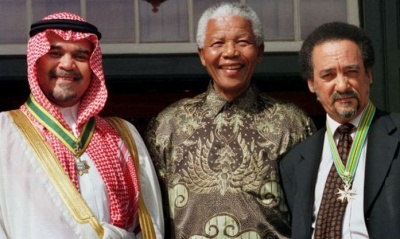
According to Paul Foot's article "Lockerbie: the Flight from Justice", Nelson Mandela was irritated by the continued sanctions on Libya. He was friendly with Colonel Gaddafi, who had contributed generously to the African National Congress, Mandela’s party, when it was engaged in illegal and armed opposition to the apartheid regime.
President Mandela firmly believed that Libya was being singled out for special hostility by the United States and, in the case of Lockerbie, he regarded the treatment of Libya as unfounded and unfair. To the intense irritation of the US State Department, Mandela launched a diplomatic offensive to persuade Gaddafi to release the two accused Libyan men for trial by Scottish judges in Europe.
President Mandela chose as his chief negotiator and plenipotentiary his most trusted adviser and confidant, the secretary to the South African Cabinet and head of the country’s civil service, Professor Jakes Gerwel, former Vice-Chancellor of the University of the Western Cape. Mandela also persuaded Prince Bandar bin Sultan of Saudi Arabia to take part in the negotiations with Gaddafi. The Prince and the Cabinet Secretary, Mandela knew, were trusted by the Libyan president as much as anyone else in the world.
The negotiations went on for a year until 5 April 1999 when the two suspects (Abdelbaset al-Megrahi and Lamin Khalifah Fhimah), finally gave themselves up for trial by Scottish judges under Scottish law (with one exception: everyone agreed that the men should be tried without a jury).[30]
Blackout of Mandela blueprint
It eventually transpired that Robert Black QC, Emeritus Professor of Scots Law at Edinburgh University, was recruited by South African intelligence and financed by tycoon Tiny Rowland to frustrate all of Nelson Mandela’s plans for Lockerbie justice:[31]
a. Black ensured that the Lockerbie trial was not held in a neutral country. Instead, he arranged for the trial to be conducted from May 2000 to January 2001 at Camp Zeist, a former US Air Force base in the Netherlands which, for the duration of the trial, became British territory;
b. Black decreed that Scotland’s Crown Office would be the ‘complainant’ at the trial;
c. Black arranged for Scotland’s Lord Advocate (Colin Boyd) to be the ‘prosecutor’ at the trial; and,
d. Black insisted that – instead of ‘independent judges’ at the trial – all four Judges (Lords Sutherland, Coulsfield, MacLean and Abernethy) had to be from Scotland.
Although one of the two accused Libyans was found not guilty of the Lockerbie bombing, it was thanks to Professor Black that the other Libyan, Abdelbaset al-Megrahi, was found guilty.[32]
Mandela visits Megrahi
On 10 June 2002, Nelson Mandela visited Abdelbaset al-Megrahi for more than an hour at Barlinnie Jail in Glasgow. Megrahi described the meeting thus:
- "Three months after my transfer to Barlinnie, Nelson Mandela kept his promise to visit me. That the world’s most respected statesman should again take the trouble to demonstrate his solidarity gave me a great lift. We chatted for sometime, mainly about the unjust guilty verdict. Having spent 27 years imprisoned on Robben Island, the agonies of prison life were etched into his soul. He asked me about my living conditions, the standard of my food and my bed, clearly aware of the huge importance of those things to a prisoner’s well-being. Before he left I introduced him again to my family, who thanked him and presented him with a bouquet of flowers. I was allowed to take photographs of him in the reception area and he signed my Arabic version of his book 'Long Walk to Freedom', which describes his prison years. In it he wrote:
- 'To Comrade Megrahi, Best wishes to one who is in our thoughts and prayers continuously. Mandela'."[33]
Following the meeting which took place in Megrahi's own cell within the prison, in a section nicknamed by other inmates as "Gaddafi's Cafe", Mandela held a 30-minute press conference and called for a fresh appeal in the case.
- "Megrahi is all alone," Mandela said. "He has nobody he can talk to. It is a psychological persecution that a man must stay for the length of his long sentence all alone." He added that al-Megrahi was being "harassed" by other inmates at Barlinnie. "He says he is being treated well by the officials but when he takes exercise he has been harassed by a number of prisoners," said Mr Mandela. "He cannot identify them because they shout at him from their cells through the windows and sometimes it is difficult even for the officials to know from which quarter the shouting occurs."
Mandela continued:
- "It would be fair if Mr Megrahi was transferred to a Muslim country - and there are Muslim countries which are trusted by the West. It will make it easier for his family to visit him if he is in a place like the Kingdom of Morocco, Tunisia or Egypt."
Mandela described in detail how a four-judge commission from the Organisation of African Unity had criticised the basis by which Megrahi came to be convicted at a special Scottish court, sitting at Camp Zeist in the Netherlands in 2001:
- "They have criticised it fiercely, and it will be a pity if no court reviews the case itself. From the point of view of fundamental principles of natural law, it would be fair if he is given a chance to appeal either to the Privy Council or the European Court of Human Rights."
Concluding his remarks, Nelson Mandela said he also hoped to meet Prime Minister Tony Blair and US President George Bush to discuss the Megrahi case.[34][35]
Mandela snubs Obama
On 18 July 2013 - his 95th birthday - Nelson Mandela awoke in his hospital bed from the long coma into which circumstances and the media had steeped him, thus avoiding the hypocrisy of having to greet President Barack Obama. Why didn't Mandela want to shake Obama's hand?
What had happened since the young Senator Obama posed triumphantly beside Nelson Mandela in 2005? (A picture of Nelson Mandela’s only meeting with US President Barack Obama now sits on the South African icon’s desk, alongside a photo of Muhammad Ali. Published in February 2011 for the first time, the photograph shows Obama, then a little-known junior Senator, having his one and only meeting with Nelson Mandela, in a hotel room in Washington, DC, in May 2005. Even the Nelson Mandela Foundation admitted they had "no idea" the two men had ever met – until Obama sent the photograph to Mandela as a gift last year, inscribed with the words, "An inspiration to us all". Verne Harris, Mandela’s chief archivist, said: "There is no archival record of that meeting that we've been able to locate, apart from this photograph," he said. "The meeting was not part of the schedule, but someone said: 'Madiba, look, you have to meet Senator Obama'. He said: 'Great, I’m happy to do that'.")[36]
Barack Obama had become President of the United States. And the black son of Africa had become one of Africa’s worst predators. From the machinations in Côte d'Ivoire to the partitioning of Sudan, through the destruction of the Libyan nation and its transformation into a haven for jihadists. During his first trip as Head of State to South Africa, Obama was not able to meet with former president Nelson Mandela, who had simply made out to be dying in his hospital bed to avoid shaking hands with someone whom he calls "the murderer of my friend and brother Muammar Gaddafi", a man who had done so much to help the ANC freedom fighters during his years in prison.
To understand why Mandela would play dead to avoid meeting the US President, we must scroll back one month before Obama's arrival in South Africa. The new Libya officials under Obama (since those in power were installed by Obama and his administration) demanded that South Africa refund the billions of dollars that Colonel Gaddafi had invested in that country to counter white hegemony. This was the straw that broke the camel's back vis-a-vis South Africa's first democratically elected president, Nelson Mandela.[37]
It was the British newspaper Sunday Times of May 2013, which published the figure of $80 billion that Obama, through his Libyan friends, is presently demanding of African countries under the pretext of a recuperation, as grotesque as it is scandalous, of "all funds and assets held illegally, obtained, looted, deposited or concealed in South Africa and neighbouring countries by the late Muammar Gaddafi." This is what the letter addressed by both the Libyan Ministries of Justice and Finance demanded of their South African counterparts. The only official response from South Africa to date is from Jabulani Sikhakhane, spokesman for the South African Finance Minister Pravin Gordhan which arrived on 2 June 2013: "The process of verifying the request by the Libyan authorities is ongoing."[38]
When on 30 June 2013, President Obama visited Mandela’s former prison cell on Robben Island off the Cape in South Africa, he said: "Nelson Mandela is the father I wanted to be."[39] We must ask ourselves one simple and obvious question: "Is Obama the son that Mandela would have wanted?" To answer this question, we should remind ourselves of the most significant act by Nelson Mandela as president of South Africa before he left office, recalling his own words uttered just a few hundred yards from where Obama would stand in the city of Cape Town. On the day he left office, he wanted to enshrine on the marble of South African history something dear to his heart. It was indeed a two-for-one gesture: he wanted to formalise his personal friendship with the Libyan leader Muammar Gaddafi who was the guest of honour at his farewell ceremony and would set the seal on the friendship between the Libyan and South African peoples.
It is June 13th, 1999 in Cape Town. This is the last day of Nelson Mandela's presidency. He held a grand celebration to bid farewell to the people of South Africa and to communicate his public will as a statesman. This will to future generations of Africans in general is the pact of friendship between South Africa and Libya, at two opposite ends of the African continent. Kwame Nkrumah wanted to unite Africa from the Cape to Cairo. Nelson Mandela sought to unite Africa from the Cape to Gaddafi's hometown of Sirte. He wanted to thank the one person whom he called his friend and brother, the Libyan leader Colonel Gaddafi. The high-point of this touching ceremony was Mandela’s speech and his moving words:
- "It was pure expediency to call on democratic South Africa to turn its back on Libya and Gaddafi, who had assisted us in obtaining democracy at a time when those who now made that call were the friends of the enemies of democracy in South Africa. Had we heeded those demands, we would have betrayed the very values and attitudes that allowed us as a nation to have adversaries sitting down and negotiating in a spirit of compromise."
The full text of the speech was sent by Mandela to President Jacob Zuma on 21 February 2011 with a message as clear as spring water: "We cannot turn our backs on Gaddafi". This was all in vain, since on 17 March 2011, Jacob Zuma went against all expectations and yielded to pressure from Barack Hussein Obama and delivered the decisive South African vote at the UN Security Council which allowed predators to hunt and kill the very architect of South African democracy, Muammar Gaddafi.[40]
SA mercenaries "betrayed Gaddafi"
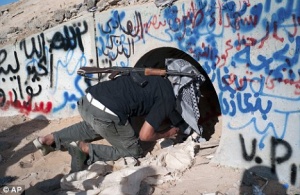
According to a South African News24 report published on 30 October 2011, Colonel Gaddafi sought help from the private security industry to get him out of his hometown of Sirte, where he was under siege by NATO and rebel forces, and "bring him to South Africa". The recruitment of South African mercenaries was done by Sarah Penfold, a well-known name in the industry based in Kenya, who apparently acted on behalf of a company in London. The SA mercenaries were led to believe that they would be rescuing Gaddafi and taking him to "live in a tent in the Karoo", but they actually helped him from the frying pan into the fire.
Speaking to one of the South African operators who was at Gaddafi’s side and a senior source in the intelligence world, City Press discovered the mercenaries were probably also misled into thinking they were helping Gaddafi. Their involvement was really only part of a larger plan to capture Gaddafi, it now appears. South Africa's State Security Agency is aware of Sarah Penfold's visit to Johannesburg on 17 August 2011, and she is being investigated.[41]
Gaddafi's demands
Muammar Gaddafi himself apparently requested assistance from the private security industry. Subsequently, negotiations were held in which he allegedly made demands concerning his planned stay in South Africa. One of the operators, Danie Odendaal, told City Press that in his correspondence Gaddafi insisted he be accommodated in a tent in a hot region – preferably desert-like. He said they speculated that the only suitable place in South Africa would be the Karoo.
After being issued with false passports, three groups of South Africans flew to Dubai and Cairo, from where they hurriedly flew to Libya to assist Gaddafi. But things turned into a "disgusting, disgusting orgy" when Nato forces fired on Gaddafi’s convoy before transitional government soldiers captured and executed him on 20 October 2011.
Abortive project
Afterwards, the details and the incredible "coincidence" of the abortive project started unfolding. City Press has discovered there was no request to the South African authorities to bring Gaddafi, a fugitive from the International Criminal Court, here. It would never have been allowed, a reliable government source said. Intelligence sources believe there were agents among the mercenaries, or in some of the security companies, who were spying for the transitional government and reporting on the mercenaries’ movements. Nato launched its attack on Gaddafi with deadly precision, and Odendaal believes someone "sold them out". There is another group of South Africans in Libya, but City Press has learned they are not under arrest. They come and go as they like, and some live in hotels.
No-one wants to comment
Former South African Police Commissioner George Fivaz said he received a call from a man in London last week who wanted to hire a 50-seat air ambulance to fetch people in Libya. Fivaz told him he couldn’t help him. City Press telephoned a security company in London for comment about allegations they had contracted the South Africans through Penfold. Initially, an employee immediately ended the call. Another employee, who only identified himself as "Harry", at first said they didn’t have any operations in Libya. Later he said "no-one will comment about this". Despite many telephone calls, Sarah Penfold couldn’t be reached for comment. The South African government doesn’t want to become involved, and it's not clear how the mercenaries will be taken out of Libya.
State Security Agency spokesperson Brian Dube said they didn’t wish to comment at this stage.
Retraction
On 30 October 2011, City Press published a report entitled "SA Mercenaries were misled". The report referred to allegations that the London based Hart Security had contracted South African mercenaries through an intermediary to render certain services in Libya. The reference to Hart Security in the report was published in error. City Press regrets the error and retracts the allegation.[42]
Personal life
Nelson Mandela has been married three times, has fathered six children, has twenty grandchildren, and a growing number of great-grandchildren. He is grandfather to Chief Mandla Mandela.
First marriage
Mandela's first marriage was to Evelyn Ntoko Mase who, like Mandela, was also from what later became the Transkei area of South Africa, although they actually met in Johannesburg. The couple broke up in 1957 after 13 years, divorcing under the multiple strains of his constant absences, devotion to revolutionary agitation, and the fact she was a Jehovah's Witness, a religion which requires political neutrality. Mase died in 2004. The couple had two sons, Madiba Thembekile (Thembi) (1946–1969) and Makgatho Mandela (1950–2005), and two daughters, both named Makaziwe Mandela (known as Maki; born 1947 and 1953). Their first daughter died aged nine months, and they named their second daughter in her honour. All their children were educated at the United World College of Waterford Kamhlaba. Thembi was killed in a car crash in 1969 at the age of 23, while Mandela was imprisoned on Robben Island, and Mandela was not allowed to attend the funeral. Makgatho died of AIDS in 2005, aged 54.
Second marriage
Mandela's second wife, Winnie Madikizela-Mandela, also came from the Transkei area, although they, too, met in Johannesburg, where she was the city's first black social worker. They had two daughters, Zenani (Zeni), born 4 February 1958, and Zindziswa (Zindzi) Mandela-Hlongwane, born 1960. Zindzi was only 18 months old when her father was sent to Robben island. Later, Winnie would be deeply torn by family discord which mirrored the country's political strife; while her husband was serving a life sentence in the Robben Island prison, her father became the agriculture minister in the Transkei. The marriage ended in separation (April 1992) and divorce (March 1996), fueled by political estrangement.
Mandela was still in prison when his daughter Zenani was married to Prince Thumbumuzi Dlamini in 1973, elder brother of King Mswati III of Swaziland. Although she had vivid memories of her father, from the age of four up until sixteen, South African authorities did not permit her to visit him. In July 2012, Zenani was appointed ambassador to Argentina, becoming the first of Mandela's three remaining children to enter public life.
Third marriage
Mandela remarried on his 80th birthday in 1998, to Graça Machel née Simbine, widow of Samora Machel, the former Mozambican president and ANC ally who was killed in an air crash 12 years earlier.
Health
On 28 March 2013, Nelson Mandela was readmitted to hospital with a lung infection, the fourth time he has been hospitalised in just over two years. Early in March 2013, Mandela spent a night in hospital following a check-up. The treatment he received in December 2012 was his longest spell in hospital since leaving prison in 1990. After the December 2012 treatment, doctors said he should remain at his home in the Johannesburg neighbourhood of Houghton to be close to medical facilities.[43]
The 95-year-old was admitted with a recurring lung infection on 8 June 2013. People from South Africa and around the world have sent him their best wishes, and flowers and other tributes have collected outside Pretoria's MediClinic Heart Hospital. Throughout Nelson Mandela's stay in hospital, President Jacob Zuma has urged the country to pray for him and keep him in their thoughts.[44]
On 1 September 2013, Nelson Mandela left hospital and returned home. The South African presidency statement says:
- "His team of doctors are convinced that he will receive the same level of intensive care at his Houghton home that he received in Pretoria [hospital]." It says his home in the suburb of Houghton has been "reconfigured to allow him to receive intensive care there" and he will be treated by the same health care personnel who have been looking after him since 8 June.[45]
He first contracted tuberculosis in the 1980s while detained on the windswept Robben Island where he served 18 of the 27 years he was imprisoned for sabotage. His lungs are said to have been damaged when he worked in a prison quarry. Despite his long imprisonment, Mandela forgave his former enemies and as president urged South Africans of all races to work together and seek reconciliation.
Nelson Mandela retired from public life in 2004 and has been rarely seen in public since. His last public appearance was at the 2010 football World Cup, which South Africa hosted. His main home is in Qunu, a small rural village in Eastern Cape province, where he says he spent the happiest days of his childhood and where, on 15 December 2013, Nelson Mandela was buried.
Related Documents
| Title | Type | Publication date | Author(s) | Description |
|---|---|---|---|---|
| Document:15 times when Jeremy Corbyn was on the right side of history | Article | 29 July 2015 | Paul Simpson | "The important thing is how we bring about peace, not posturing. You do not bring about peace in any part of the world without talking to people you don't agree with." (#SundayPolitics, 19 July 2015) |
| Document:A dissenting opinion on Nelson Mandela | article | 6 December 2013 | Jonathan Cook | |
| Document:Good Liberation Hero-Bad Liberation Hero | article | 9 December 2013 | Stephen Gowans | |
| Document:How Mandela sold out blacks | open letter | 17 July 2012 | Youngster | Bitter criticism of Nelson Mandela for capitulating to the apartheid regime and for failing to ensure that South Africa's mines, banks and minerals were "transferred to the ownership of the people as a whole" as required by the Freedom Charter. |
| Document:Justice for Megrahi - Black's lies matter | Letter | 18 April 2021 | Patrick Haseldine | Don't let Suppressor Black mess up again at the UK/Supreme Court: much better to employ an English lawyer such as Gareth Peirce with a proven track record of success (Guildford Four, Birmingham Six etc.) |
| Document:Mandela: What the Obits Omit | article | 9 December 2013 | Jim Goad | |
| Document:Rebranded revolutionaries: Mandela, Gaddafi and Corbyn | Article | 4 September 2016 | Dewi Asianab | This article is not about Mandela. It is not about Gaddafi, nor is it even really about Corbyn. It is about ideology. That of self determination, the idea that imperialist forces must be repelled and fought at every corner. It is about international solidarity with those who seek refuge from oppressors. It is about three men who share a vast amount in common.<a href="#cite_note-1">[1]</a> |
| Document:Reinstatement in HM Diplomatic Service | Letter | 6 January 1997 | Patrick Haseldine | A plea for reinstatement in the Foreign and Commonwealth Office by "Thatcher's Whitehall Critic" |
References
- ↑ "Blair thanks Mandela Lockerbie effort"
- ↑ "South Africa's Nelson Mandela dies"
- ↑ "A National Service of Thanksgiving to Celebrate the Life and Work of Nelson Mandela"
- ↑ "Jacob Zuma pulls out of Nelson Mandela memorial at Westminster Abbey"
- ↑ "Obama Meets Privately With Nelson Mandela's Family, Will Not Visit Hospital"
- ↑ "Barack Obama and Raúl Castro among speakers at Nelson Mandela memorial"
- ↑ "David Cameron poses for selfie with Barack Obama at Nelson Mandela's memorial"
- ↑ "Nelson Mandela's former PA hits out at 'disgraceful' government handling of his death"
- ↑ "Nelson Mandela memorial service held at Westminster Abbey"
- ↑ "He was put on trial for treason between 1956 and 1961, and was acquitted in 1961"
- ↑ "Mandela Biography"
- ↑ "Letter of 30 March 2001 from Nelson Mandela to Thomas Friedman"
- ↑ "What did you do in the struggle, daddy? The real story of Nelson Mandela and the communists"
- ↑ "Lockerbie: Bernt Carlsson's secret meeting in London"
- ↑ "ANC as the fall-guys for Lockerbie bombing" Patrick Haseldine's letter to The Guardian, 22 April 1992
- ↑ "Exiles' Cheers Greet Mandela on Zambia" Visit : Africa: The ANC leader leaves South Africa for the first time in a quarter century. He says he wants to meet 'heroes' in the fight against apartheid.
- ↑ "What does Gaddafi's death mean for Africa?"
- ↑ "2013 BBC interview with Neil Kinnock an early supporter of Mandela" BBC1, 8 December 2013
- ↑ "Nelson Mandela's statement on the Lockerbie disaster" 21 January 1992
- ↑ "Al-Megrahi defence knew bomb fragment was sent to US"
- ↑ "Tiny Rowland: Portrait of the Bastard as a Rebel"
- ↑ "Bernt Carlsson: Assassinated on Pan Am Flight 103"
- ↑ "Why the Lockerbie flight booking subterfuge, Mr Botha?"
- ↑ "Blackout over Lockerbie"
- ↑ "TheLockerbieTrial.Com" Archive of Professor Black and Ian Ferguson website
- ↑ "Mandela plea to Major on Lockerbie trial" by Christopher Cairns, The Scotsman, 29 May 1994
- ↑ "Mandela's visit to Libya to discuss Lockerbie affair"
- ↑ "Hansard, 7 November 1997"
- ↑ Press release from Prof Robert Black" 23 April 1998
- ↑ "Lockerbie - The Flight From Justice" Paul Foot, Private Eye Special Report
- ↑ "Tiny Rowland, Lonmin and Lockerbie"
- ↑ "Blackout of Mandela Blueprint for Lockerbie Justice"
- ↑ "Nelson Mendela’s message to Megrahi"
- ↑ "Mandela meets Lockerbie bomber"
- ↑ "Mandela appeals on behalf of Lockerbie bomber"
- ↑ "Revealed: 2005 Photo of Barack Obama Meeting Nelson Mandela"
- ↑ "What if Mandela was playing 'dead', to avoid meeting Obama?"
- ↑ "DA wants documents on Gaddafi interests"
- ↑ "Obama 'humbled' to visit Mandela's Robben Island jail"
- ↑ "UN security council resolution 1973 (2011) on Libya – full text"
- ↑ "Mystery of British woman linked to Gaddafi's doomed getaway as it emerges son Saif 'is hiding in Sahara'"
- ↑ "SA Mercenaries were misled"
- ↑ "Nelson Mandela back in hospital with lung infection"
- ↑ "Nelson Mandela hospital release reports 'incorrect'"
- ↑ "Nelson Mandela discharged from South African hospital"
See also
External links
- "A Medal of Good Hope: Mandela, Gaddafi and the Lockerbie Negotiations"
- "Conservative whitewash"
- "Destroying Libya and World Order: The Three-Decade U.S. Campaign to Terminate the Qaddafi Revolution"
- "Lockerbie: Mandela and Dr John Cameron's Report"
- "From Chequers to Lockerbie"
- "Coup d'Etat in Slow Motion: Sweden & Apartheid South Africa"
